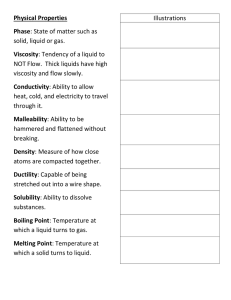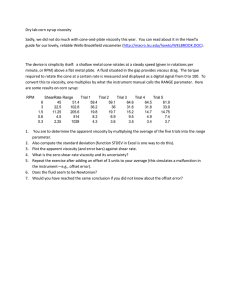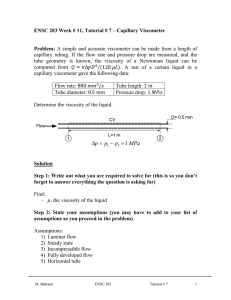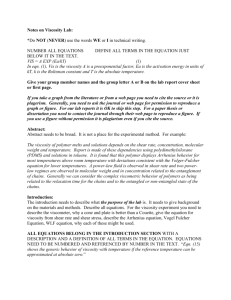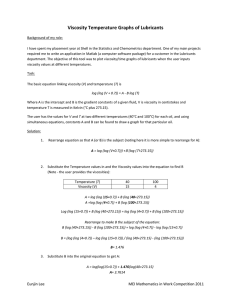LEC 01.08 Viscosity measurements with the falling ball viscometer
advertisement
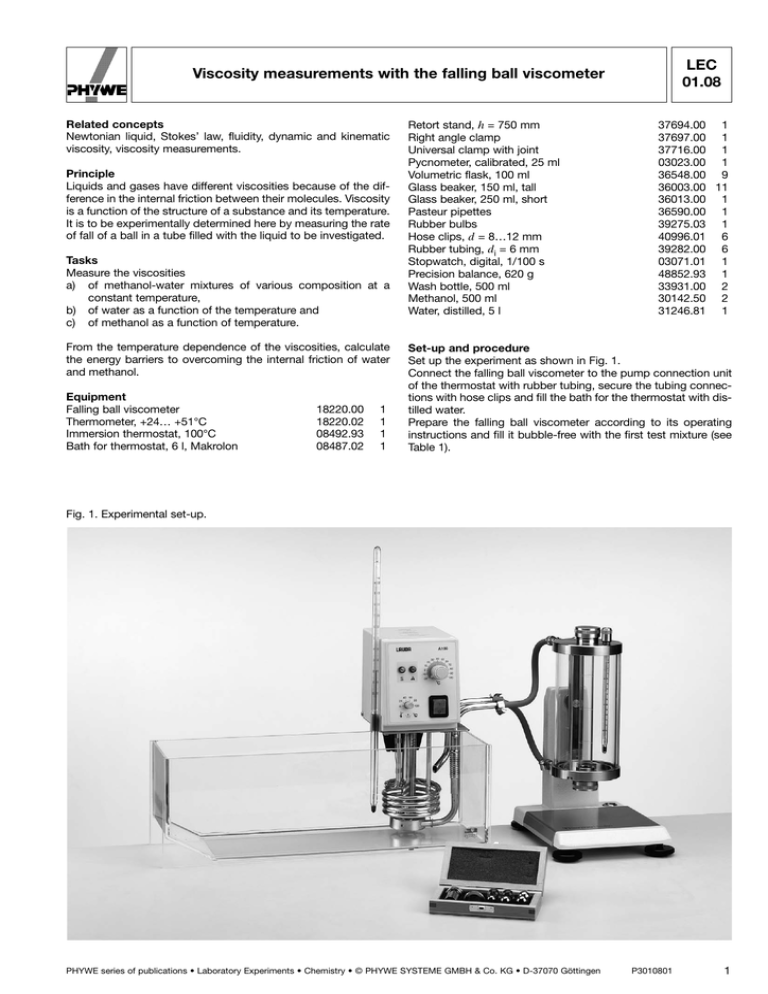
LEC 01.08 Viscosity measurements with the falling ball viscometer Related concepts Newtonian liquid, Stokes’ law, fluidity, dynamic and kinematic viscosity, viscosity measurements. Principle Liquids and gases have different viscosities because of the difference in the internal friction between their molecules. Viscosity is a function of the structure of a substance and its temperature. It is to be experimentally determined here by measuring the rate of fall of a ball in a tube filled with the liquid to be investigated. Tasks Measure the viscosities a) of methanol-water mixtures of various composition at a constant temperature, b) of water as a function of the temperature and c) of methanol as a function of temperature. From the temperature dependence of the viscosities, calculate the energy barriers to overcoming the internal friction of water and methanol. Equipment Falling ball viscometer Thermometer, +24… +51°C Immersion thermostat, 100°C Bath for thermostat, 6 l, Makrolon 18220.00 18220.02 08492.93 08487.02 1 1 1 1 Retort stand, h = 750 mm Right angle clamp Universal clamp with joint Pycnometer, calibrated, 25 ml Volumetric flask, 100 ml Glass beaker, 150 ml, tall Glass beaker, 250 ml, short Pasteur pipettes Rubber bulbs Hose clips, d = 8…12 mm Rubber tubing, di = 6 mm Stopwatch, digital, 1/100 s Precision balance, 620 g Wash bottle, 500 ml Methanol, 500 ml Water, distilled, 5 l 37694.00 1 37697.00 1 37716.00 1 03023.00 1 36548.00 9 36003.00 11 36013.00 1 36590.00 1 39275.03 1 40996.01 6 39282.00 6 03071.01 1 48852.93 1 33931.00 2 30142.50 2 31246.81 1 Set-up and procedure Set up the experiment as shown in Fig. 1. Connect the falling ball viscometer to the pump connection unit of the thermostat with rubber tubing, secure the tubing connections with hose clips and fill the bath for the thermostat with distilled water. Prepare the falling ball viscometer according to its operating instructions and fill it bubble-free with the first test mixture (see Table 1). Fig. 1. Experimental set-up. PHYWE series of publications • Laboratory Experiments • Chemistry • © PHYWE SYSTEME GMBH & Co. KG • D-37070 Göttingen P3010801 1 LEC 01.08 Viscosity measurements with the falling ball viscometer Use ball number 1 (borosilicate glass) which is appropriate for investigations in the given viscosity range. Its characteristic data can be obtained from the test certificate. Place the ball in the gravity tube and allow the viscometer to equilibrate to a constant working temperature of T = 298 K for approximately 10 minutes. Then determine 3 falling times t. Calculate the arithmetic mean of the measured values. Repeat this procedure with each of the other test mixtures. Following this, measure the temperature dependence of the viscosity of the pure liquids in steps of 5 K in the temperature range between 293 K and 323 K. Determine the densities of water and methanol which are required for the calculations as follows; weigh the clean and dry pycnometer, fill it with water, fix it to the retort stand, and equilibrate it in the thermostatic water bath for approximately 10 minutes. Close it with the accompanying stopper, dry it quickly and reweigh it. Calculate the density of water from the mass difference of the two weighings and the volume of the pycnometer. Rinse the gravity tube and the pycnometer thoroughly with methanol, fill it with methanol and repeat the procedure as for water. Theory and evaluation The dynamic viscosity h of a liquid is defined by the force F which is required to move two parallel layers of liquid, each of area A and separated by the distance dx, one against the other with the velocity dv. h⫽ F dv A dx (1) For commercial falling ball viscometers with sets of calibrated spheres, the constants in equation (6) are combined with the apparative factors to give the spherical constant K, which makes the calculations much simpler: h ⫽ K t 1r1 ⫺ r2 2 t Rate of fall of the sphere for a measuring distance of s = 100 mm The density r2 of the liquid at temperature T which is contained in eqn. (7) can be calculated using the relationship r2 ⫽ m V h r (2) w⫽ 1 h (3) A spherical particle of radius r moving in a liquid of viscosity h under the influence of a force F reaches a constant velocity v (Stokes law) v⫽ F 6phr m V (8) Mass of the liquid Volume of the pycnometer Viscosity is a function of the structure and the temperature. The changes in the measured viscosities of the methanol-water-mixtures is a consequence of the non-ideal behaviour of the liquids. It correlates to additional mixing phenomena such as volume contraction and mixing enthalpy. w1 ⫽ wi mi On relating the dynamic viscosity to the density r of the liquid, the kinematic viscosity n is obtained (2). The reciprocal of the dynamic viscosity is designated as the fluidity w (3). n⫽ (7) Fig. 2: (9.1) Mass fraction Mass of substance i x1 ⫽ xi ni mi Mi m1 m1 ⫹ m2 m1 M1 n1 ⫽ m1 m2 n1 ⫹ n2 ⫹ M1 M2 (9.2) Mole fraction Quantity of substance i Mass of substance i Molar mass of substance i Dependence of the viscosity h of the methanol-water system on the composition described by the mass fraction w at constant temperature (T = 298 K) (4) For the fall of a sphere in the gravitational field of the earth the motive force F is equal to the product of the acceleration of gravity g and the effective mass m’ which can be expressed as the density difference between the sphere (r1) and the liquid (r2). F ⫽ m' g ⫽ 4 3 pr 1r1 ⫺ r2 2g 3 (5) The correlation (6) for the calculation of the viscosity which is derived from (4) and (5) is only considered to be a limiting law for expanded media (the radius can be neglected with respect to that of the gravity tube). h⫽ 2 P3010801 2 r2 1r1 ⫺ r2 2 g 9v (6) PHYWE series of publications • Laboratory Experiments • Chemistry • © PHYWE SYSTEME GMBH & Co. KG • D-37070 Göttingen LEC 01.08 Viscosity measurements with the falling ball viscometer For many liquids, the decrease in viscosity with increasing temperature can be described by the following empirically determined function. E 1 ⫽ w ⫽ C e ⫺ RT (10) h R = 8.31441 J · K-1 · mol-1 Universal gas constant In this relationship, which is analogous to the Arrhenius equation, C represents a system-dependent constant, and E is an expression of the molar energy which is required to overcome the internal friction. This activation energy can be determined from the slope obtained by the linear relation between ln h and 1/T (Fig.4). E 1 ln h ⫽ · ⫺ ln C (10.1) R T Fig. 3: Dependence of the viscosity h of the methanol-water system on the composition described by the mole fraction x at constant temperature (T = 298 K) Data and results The experimentally determined viscosities are presented graphically in the Figures 2 to 4 as a function of the composition of the methanol-water mixtures and the temperature. The following values are determined for the slopes of the linear relationships between ln h and 1/T which are obtained by linear regression analysis: ∆(ln h) / ∆(1/T) = 1.799 · 103 K (H2O) and ∆(ln h) / ∆(1/T) = 1.134 · 103 K (CH3OH). Substituting these values in equation 10.1, the corresponding energy barriers are obtained E = 14.8 kJ · mol-1 (H2O) and E = 9.4 kJ · mol-1 (CH3OH). The energy barriers which are obtained using the literature values for h (given in Table 2) are E = 15.9 kJ · mol-1 and E = 11.1 kJ · mol-1. Fig. 4: Temperature dependence of the dynamic viscosity h of water (o) and methanol (+), respectively PHYWE series of publications • Laboratory Experiments • Chemistry • © PHYWE SYSTEME GMBH & Co. KG • D-37070 Göttingen P3010801 3 LEC 01.08 4 P3010801 Viscosity measurements with the falling ball viscometer PHYWE series of publications • Laboratory Experiments • Chemistry • © PHYWE SYSTEME GMBH & Co. KG • D-37070 Göttingen

